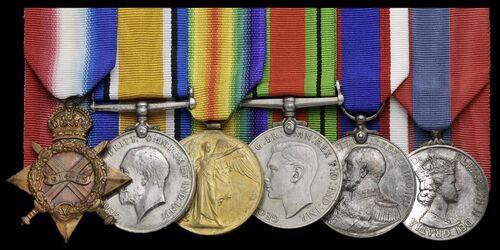
Auction: 23001 - Orders, Decorations and Medals
Lot: 139
Six: Leading Signalman R. Shaw, Royal Navy, who took part in the Battles of Dogger Bank and Jutland later being was sunk with H.M.S. Nottingham in the Action of 19 August 1916
1914-15 Star (J.28412, R. Shaw, Sig., R.N.); British War and Victory Medals (J.28412 R. Shaw. L. Sig. R.N.); Defence and War Medals 1939-45; Royal Fleet Reserve L.S. & G.C., G.V.R. (J.28412 [Dev.B.10161] R. Shaw. L Sig. R.F.R.); Imperial Service Medal (Richard Shaw), E.R.II, good very fine (6)
Richard Shaw was born Stockport, Cheshire on 31 October 1896 and enlisted on 19 November 1913 as Boy Class II. Posted to Ganges he saw the rest of year out there, reaching his majority on 5 June 1914. Promoted Ordinary Signaller on 31 October with Vivid I, Shaw was posted to the town-class Light Cruiser Nottingham on 13 November.
Part of Harwich Force she had already been in action - before Shaw came aboard - at the Battle of Heligoland Bight. Later she was to be in on the action at the Battle of Dogger Bank where she aided in the destruction of the armoured cruiser Blucher which was overhauled and sunk by the combined firepower of the British Fleet. Nottingham and her sisters were transferred to the 2nd Light Cruiser Squadron.
Still with this formation on 31 May 1916 she joined them as they sallied into the North Sea with the Battlecruiser Fleet under Admiral Beatty. It was this Squadron -during the 'Run to the South' - which identified the German High Seas Fleet approaching in support of Admiral Hipper. Despite being under fire from the enemy Battleships for over an hour none of the squadron were hit, thanks to their clever navigation. That changed later in the battle when they ran into a German Light Cruiser formation in the dark.
The enemy focused their fire on Southampton while Nottingham and Birmingham didn't switch on their lights and this did not draw fire. Nottingham herself fired a total of 136 of her 6-inch shells without receiving a hit in exchange.
The High Seas Fleet launched another sortie, soon after the Battle of Jutland, on 19 August 1916. The British moved to intercept them but as they swept south Nottingham came into the sights of U52. Two torpedoes struck in quick succession, knocking out power to the vessel however she was not in danger of sinking. U-52 was watching her victim however and when it became clear that she was still afloat a third torpedo was launched which rendered her beyond saving.
Shaw survived the sinking and went on to serve with H.M.S. Glorious for the last year of the war. He later saw post-war service with H.M.S. Seawolf joining the Royal Fleet Reserve on 28 February 1920. Remaining mobilised with this unit at Vivid I he was not demobilised until 9 June 1921. After the war Shaw lived in Manchester and worked as Overseer in a Post Office, being awarded the Imperial Service Medal here on 25 June 1957; sold together with copied service papers and a London Gazette entry.
Subject to 20% VAT on Buyer’s Premium. For more information please view Terms and Conditions for Buyers.
Sold for
£240
Starting price
£110




